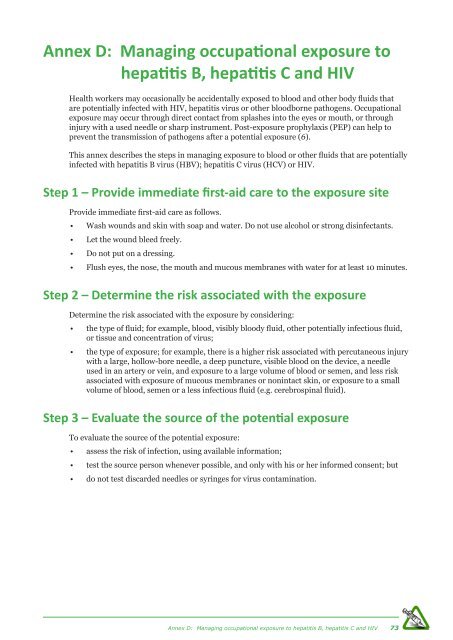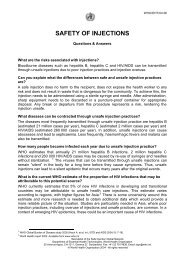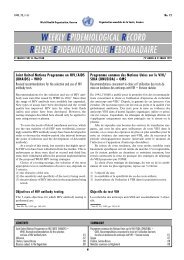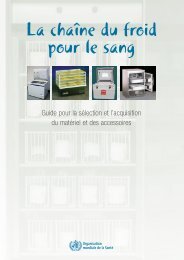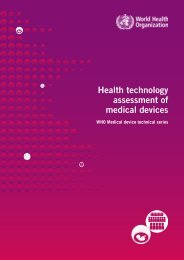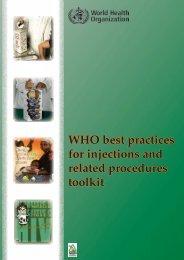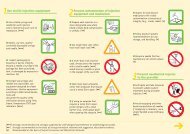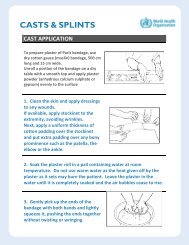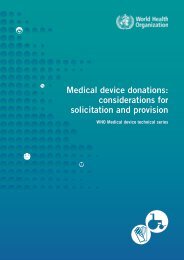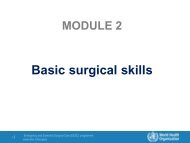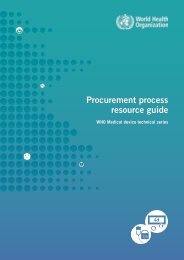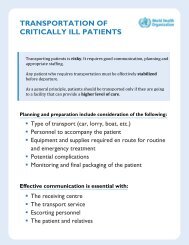WHO Guidelines on Drawing Blood: Best Practices in Phlebotomy
WHO Guidelines on Drawing Blood: Best Practices in Phlebotomy
WHO Guidelines on Drawing Blood: Best Practices in Phlebotomy
- No tags were found...
You also want an ePaper? Increase the reach of your titles
YUMPU automatically turns print PDFs into web optimized ePapers that Google loves.
Annex D: Manag<strong>in</strong>g occupati<strong>on</strong>al exposure to<br />
hepatitis B, hepatitis C and HIV<br />
Health workers may occasi<strong>on</strong>ally be accidentally exposed to blood and other body fluids that<br />
are potentially <strong>in</strong>fected with HIV, hepatitis virus or other bloodborne pathogens. Occupati<strong>on</strong>al<br />
exposure may occur through direct c<strong>on</strong>tact from splashes <strong>in</strong>to the eyes or mouth, or through<br />
<strong>in</strong>jury with a used needle or sharp <strong>in</strong>strument. Post-exposure prophylaxis (PEP) can help to<br />
prevent the transmissi<strong>on</strong> of pathogens after a potential exposure (6).<br />
This annex describes the steps <strong>in</strong> manag<strong>in</strong>g exposure to blood or other fluids that are potentially<br />
<strong>in</strong>fected with hepatitis B virus (HBV); hepatitis C virus (HCV) or HIV.<br />
Step 1 – Provide immediate first-aid care to the exposure site<br />
Provide immediate first-aid care as follows.<br />
• Wash wounds and sk<strong>in</strong> with soap and water. Do not use alcohol or str<strong>on</strong>g dis<strong>in</strong>fectants.<br />
• Let the wound bleed freely.<br />
• Do not put <strong>on</strong> a dress<strong>in</strong>g.<br />
• Flush eyes, the nose, the mouth and mucous membranes with water for at least 10 m<strong>in</strong>utes.<br />
Step 2 – Determ<strong>in</strong>e the risk associated with the exposure<br />
Determ<strong>in</strong>e the risk associated with the exposure by c<strong>on</strong>sider<strong>in</strong>g:<br />
• the type of fluid; for example, blood, visibly bloody fluid, other potentially <strong>in</strong>fectious fluid,<br />
or tissue and c<strong>on</strong>centrati<strong>on</strong> of virus;<br />
• the type of exposure; for example, there is a higher risk associated with percutaneous <strong>in</strong>jury<br />
with a large, hollow-bore needle, a deep puncture, visible blood <strong>on</strong> the device, a needle<br />
used <strong>in</strong> an artery or ve<strong>in</strong>, and exposure to a large volume of blood or semen, and less risk<br />
associated with exposure of mucous membranes or n<strong>on</strong><strong>in</strong>tact sk<strong>in</strong>, or exposure to a small<br />
volume of blood, semen or a less <strong>in</strong>fectious fluid (e.g. cerebrosp<strong>in</strong>al fluid).<br />
Step 3 – Evaluate the source of the potential exposure<br />
To evaluate the source of the potential exposure:<br />
• assess the risk of <strong>in</strong>fecti<strong>on</strong>, us<strong>in</strong>g available <strong>in</strong>formati<strong>on</strong>;<br />
• test the source pers<strong>on</strong> whenever possible, and <strong>on</strong>ly with his or her <strong>in</strong>formed c<strong>on</strong>sent; but<br />
• do not test discarded needles or syr<strong>in</strong>ges for virus c<strong>on</strong>tam<strong>in</strong>ati<strong>on</strong>.<br />
Annex D: Manag<strong>in</strong>g occupati<strong>on</strong>al exposure to hepatitis B, hepatitis C and HIV 73


